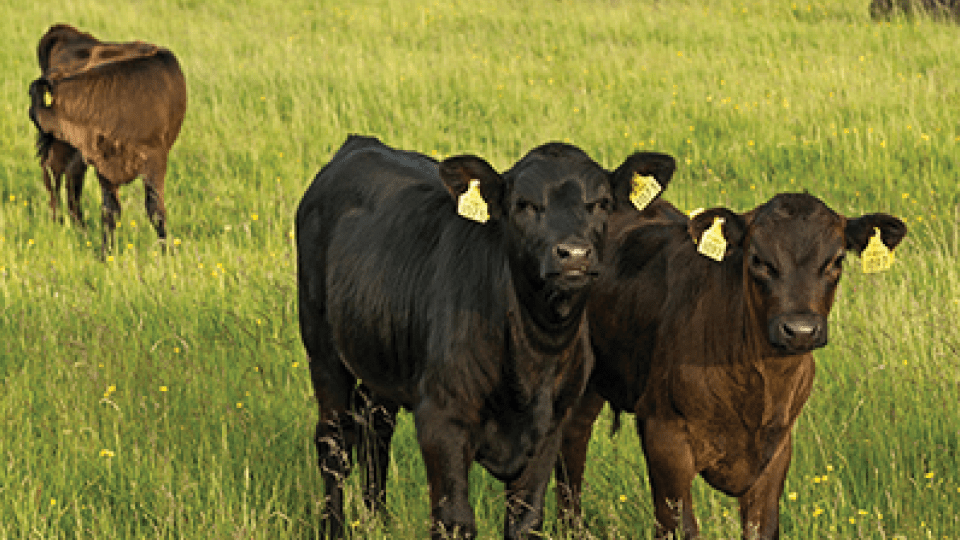Top five reasons to implant calves at weaning
By Dr. Lee-Anne Walter
With weaning time approaching, consider the productivity and revenue benefits of including implants in cattle preconditioning programs. Here are five reasons to implant calves before they head to the feedlot:

- Economic benefit, even in short preconditioning phase. Research shows RALGRO® (zeranol implants) improves average daily gain (ADG) in backgrounding cattle by close to 10%.1-5 Assuming cattle gain 2 pounds per day without an implant during a 60-day preconditioning period, implanting with RALGRO would improve ADG to 2.2 pounds per day. That equates to 12 additional pounds of weight gain over 60 days.
- Additive weight gain from implanting. The right implant achieves a positive ROI at each stage of production. One study showed that RALGRO-implanted calves were 19 pounds heavier after the suckling phase and continued to gain more during the growing phase. Cattle implanted at both suckling and growing phases were 40 pounds heavier than calves never receiving an implant.6 Another study found cattle implanted with RALGRO at suckling, backgrounding and finishing phases were heavier at finishing than animals receiving an implant only at the start of finishing.7
- Implants work quickly. Zeranol – the active ingredient in RALGRO – reaches effective levels within the first day of administration and peaks in as few as eight days after implanting. Plasma levels remain elevated up to 91 days post-implanting.8
- Higher value calves at sale time. Data from Superior Livestock consistently shows no difference in sale price per hundredweight for implanted versus non-implanted calves.9 Therefore, producers can gain more revenue by using implants to market higher weight calves. Any non-hormone treated cattle (NHTC) program premium would need to outweigh the productivity gains from using RALGRO.
- Easy to use. The RALGRO RALOGUN® is one of the most reliable devices in the industry, with a small needle diameter that reduces tissue trauma.
It Pays to Implant
Implanting remains one of the most researched and consistent technologies available to cattle producers. With proven results for more than 50 years, RALGRO is approved for use in calves, stockers and feedlot cattle on both steers and heifers.
Important Safety Information
RALGRO: Not for use in humans. Keep out of reach of children. No withdrawal period is required when used according to labeling. Do not use in beef calves less than 2 months of age, dairy calves, and veal calves. A withdrawal period has not been established for this product in pre-ruminating calves. Do not use in replacement beef heifers after weaning or in dairy cows or replacement dairy heifers. Use in these cattle may cause drug residues in milk and/or calves born to these cows. Implant pellets subcutaneously in ear only. Any other location is a violation of Federal law. Do not attempt salvage of implanted site for human or animal food. Not approved for repeated implantation (reimplantation) with this or any other cattle ear implant within a single production phase as safety and effectiveness have not been evaluated. For complete safety information, refer to the product label.
References
- Simms DD, Goehring TB, Brandt RT, Jr, Kuhl GL, Higgins JJ, Laudert SB, Lee RW. 1988. Effect of sequential implanting with zeranol on steer lifetime performance. J. Anim. Sci. 66:2736–2741.
- Mader TL, Clanton DC, Ward JK, Pankaskie DE, Duetscher GH. 1985. Effect of pre- and postweaning zeranol implant on steer calf performance. J. Anim. Sci. 61:546–551.
- Thiex, PJ and Embry, LB. 1972. Diethylstilbestrol, Melengestrol Acetate and Zeranol During Growing and Finishing of Feedlot Heifers. South Dakota Cattle Feeders Field Day Proceedings and Research Reports. Paper 13.
- Embry, LB and Swan, WS. 1974. Diethylstilbestrol, Zeranol or Synovex-S Implants for Growing Steers. South Dakota Cattle Feeders Field Day Proceedings and Research Reports. Paper 4.
- Embry, LB, Goetz, MS and Luther, RM. 1982. Implanting Site for RALGRO Compared to Synovex-S for Growing and Finishing Steers. South Dakota Cattle Feeders Field Day Proceedings and Research Reports. Paper 10.
- Laudert, SB, Matsushima, JK, Wray, MW. Effect of RALGRO implant on suckling, growing and finishing cattle. 1981.
- Pritchard, RH, Bruns, KW, Boggs, DL. A comparison of lifetime implant strategies for beef steers. South Dakota Beef Report. 2003.
- Pusateri, AE, Kenison, DC. Measurement of zeranol in plasma from three blood vessels in steers implanted with zeranol. J. Anim. Sci. 1993; 71(2):415-419.
- Superior Livestock Auction data, 2014-2018.
Find more content for your beef operation.
About the author

Dr. Lee-Anne Walter, Ph.D.
Cattle Technical Services,
Merck Animal Health
